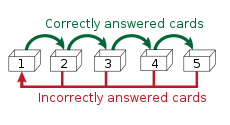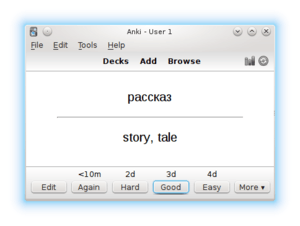Spaced repetition

Spaced repetition is a learning technique that incorporates increasing intervals of time between subsequent review of previously learned material in order to exploit the psychological spacing effect. Alternative names include spaced rehearsal, expanding rehearsal, graduated intervals, repetition spacing, repetition scheduling, spaced retrieval and expanded retrieval.[1]
Although the principle is useful in many contexts, spaced repetition is commonly applied in contexts in which a learner must acquire a large number of items and retain them indefinitely in memory. It is, therefore, well suited for the problem of vocabulary acquisition in the course of second language learning, due to the size of the target language's inventory of open-class words.
Research and applications
The notion that spaced repetition could be used for improving learning was first proposed in the book Psychology of Study by Prof. C. A. Mace in 1932: "Perhaps the most important discoveries are those which relate to the appropriate distribution of the periods of study...Acts of revision should be spaced in gradually increasing intervals, roughly intervals of one day, two days, four days, eight days, and so on."[2]
In 1939, H. F. Spitzer tested the effects of a type of spaced repetition on sixth-grade students in Iowa learning science facts.[3] Spitzer tested over 3600 students in Iowa and showed that spaced repetition was effective. This early work went unnoticed, and the field was relatively quiet until the late 1960s when cognitive psychologists, including Melton[4] and Landauer & Bjork,[5] explored manipulation of repetition timing as a means to improve recall. Around the same time, Pimsleur language courses pioneered the practical application of spaced repetition theory to language learning, and in 1973 Sebastian Leitner devised his "Leitner system", an all-purpose spaced repetition learning system based on flashcards.
With the increase in access to personal computers in the 1980s, spaced repetition began to be implemented with computer-assisted language learning software-based solutions,[6] enabling automated scheduling and statistic gathering, scaling to thousands of cards scheduled individually. To enable the user to reach a target level of achievement (e.g. 90% of all material correctly recalled at any given time point), the software adjusts the repetition spacing interval. Material that is hard appears more often and material that is easy less often, with difficulty defined according to the ease with which the user is able to produce a correct response.
Algorithms
There are several families of algorithms for scheduling spaced repetition:
- Neural networks based[7]
- Leitner system: 5 stages and an arbitrary number of stages
- SM-family of algorithms (SuperMemo): SM-0 (a paper implementation) to SM-17 (in SuperMemo 17)
Some have theorized that the precise length of intervals does not have a great impact on algorithm effectiveness,[8] although it has been suggested by others that the interval (expanded vs. fixed interval, etc.) is quite important. The experimental results regarding this point are mixed.[9]
Pimsleur's graduated-interval recall
Graduated-interval recall is a type of spaced repetition published by Paul Pimsleur in 1967.[10] It is used in the Pimsleur language learning system and is particularly suited to programmed audio instruction due to the very short times (measured in seconds or minutes) between the first few repetitions, as compared to other forms of spaced repetition which may not require such precise timings.
The intervals published in Pimsleur's paper were: 5 seconds, 25 seconds, 2 minutes, 10 minutes, 1 hour, 5 hours, 1 day, 5 days, 25 days, 4 months, and 2 years.
Software

Most spaced repetition software (SRS) programs are modeled after the manual style of learning with physical flashcards: items to memorize are entered into the program as question-answer pairs. When a pair is due to be reviewed, the question is displayed on screen, and the user must attempt to answer. After answering, the user manually reveals the answer and then tells the program (subjectively) how difficult answering was. The program schedules pairs based on spaced repetition algorithms. Without a program, the user has to schedule physical flashcards; this is time-intensive and limits users to simple algorithms like the Leitner system.[11]
Further refinements with regard to software:
- Questions and/or answers can be a sound-file to train recognition of spoken words.
- Automatic generation of pairs (e.g. for vocabulary, it is useful to generate three question-pairs: written foreign word, its pronunciation and its meaning, but data only has to be entered once.)
- Additional information retrieved automatically is available, such as example sentences containing a word.
- Opportunities to combine spaced repetition with online community functions, e.g. sharing courses.
Implementations
Notable implementations include Anki, Brainscape, Cerego, Course Hero, Duolingo, Lingvist, Memrise, Mnemosyne, Pleco Software, Quizlet, Skritter, SuperMemo, Synap and WaniKani.
References
- ↑ "Human Memory: Theory and Practice", Alan D. Baddeley, 1997
- ↑ Mace, C. A. (1932). Psychology of Study. p. 39.
- ↑ Spitzer, H. F. (1939). Studies in retention. Journal of Educational Psychology, 30, 641–657.
- ↑ Melton, A. W. (1970). The situation with respect to the spacing of repetitions and memory. Journal of Verbal Learning and Verbal Behavior, 9, 596–606.
- ↑ Landauer, T. K., & Bjork, R. A. (1978). Optimum rehearsal patterns and name learning. In M. Gruneberg, P. E. Morris, & R. N. Sykes (Eds.), Practical aspects of memory (pp. 625–632). London: Academic Press.
- ↑ See #Software
- ↑ "Implementing a neural network for repetition spacing". www.supermemo.com. Retrieved 2017-07-15.
- ↑ Cull, W. L. (2000). Untangling the benefits of multiple study opportunities and repeated testing for cued recall. Applied Cognitive Psychology, 14, 215–235.
- ↑ Chapter 6:Is Expanded Retrieval Practice a Superior Form of Spaced Retrieval?, A Critical Review of the Extant Literature, DAVID A. BALOTA, JANET M DUCHEK, and JESSICA M. LOGAN
- ↑ Pimsleur, Paul (February 1967). "A Memory Schedule". The Modern Language Journal. Blackwell Publishing. 51 (2): 73–75. doi:10.2307/321812. JSTOR 321812
- ↑ "Spaced repetition: a hack to make your brain store information", The Guardian, retrieved 2016-04-26
Further reading
- Caple, C. (1996). "The Effects of Spaced Practice and Spaced Review on Recall and Retention Using Computer Assisted Instruction". Dissertation for the degree of Doctor of Education, North Carolina State University.
- de Boer, V. (2003, August). "Optimal Learning and the Spacing Effect: Theory, Application and Experiments based on the Memory Chain Model". Artificial Intelligence Master's Thesis for Computational Psychology, University of Amsterdam.
- Dempster, F. N. (1988). "The Spacing Effect: A Case Study in the Failure to Apply the Results of Psychological Research". American Psychologist, 43(8), 627-634.
- Greene R. L. (2008). Repetition and spacing effects. In Roediger H. L. III (Ed.), Learning and memory: A comprehensive reference. Vol. 2: Cognitive psychology of memory (pp. 65–78). Oxford: Elsevier.
- The Guardian (2016). "Spaced Repetition: A hack to make your brain learn more information".
- Karpicke, J. D., & Roediger, H. L. (2007). "Expanding Retrieval Practice Promotes Short-Term Retention, but Equally Spaced Retrieval Enhances Long-Term Retention". Journal of Experimental Psychology: Learning, * Memory, and Cognition, 33(4), 704-719.
- Kerfoot, B. P.; Baker, H. E.; Koch, M. O.; Connelly, D.; Joseph, D. B.; Ritchey, M. L. (2007). "Randomized, Controlled Trial of Spaced Education to Urology Residents in the United States and Canada". The Journal of Urology. 177 (4): 1481–1487. doi:10.1016/j.juro.2006.11.074. PMID 17382760.
- Pavlik, P. I. (2005). The Microeconomics of Learning: Optimizing Paired-Associate Memory. PhD, Carnegie Mellon.
- Pavlik, P. I.; Anderson, J. R. (2008). "Using a model to compute the optimal schedule of practice". Journal of Experimental Psychology. 14 (2): 101–117. doi:10.1037/1076-898X.14.2.101. PMID 18590367.
- Dr Piotr Wozniak (Feb 1999). "Effective learning: Twenty rules of formulating knowledge". — advice on making flashcards for spaced repetition.